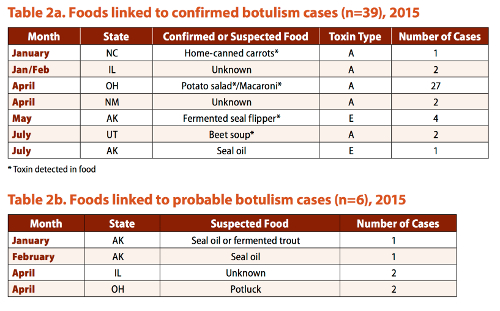Botulism poisoning has been getting a lot of attention in recent weeks and a new report from the Centers for Disease Control and Prevention shows no indication that the paralyzing pathogen is going away.

During the weeks before the CDC released its report on botulism statistics for 2015, botulism headlines had been running heavy.
An outbreak in California, which has killed one and left nine others on ventilators, and the tragic case of Otto Warmbier, the 22-year-old who was held by North Korea, have raised awareness about botulism poisoning.
In California the culprit was nacho cheese from a heated dispenser in a gas station, according to lab tests by state officials. In the case of Warmbier, who died Monday, his family says they don’t believe the North Korean officials.
One fact that is indisputable is that 2015 posted the most confirmed foodborne botulism poisoning cases in the United States than the previous four years. The percentage of botulism poisoning caused by food sources in 2015 was also higher than in the previous four years.
In addition to foodborne botulism, the CDC tracks three other categories of botulism poisoning — infant botulism, wound botulism and botulism of unknown or other sources.
The CDC statistics for 2015 botulism cases in the United States are:
 A total of 199 confirmed and 14 probable cases;
A total of 199 confirmed and 14 probable cases;- Infant botulism accounted for 141, or 71 percent, of all cases;
- Foodborne botulism accounted for 39 illnesses, or 20 percent of all cases with one death;
- Wound botulism accounted for 15 illnesses, or 8 percent of all cases; and
- Botulism of unknown or other transmission accounted for 4 illnesses, or 2 percent of all cases.
Among probable cases, foodborne botulism accounted for 6 cases and wound botulism for 8 cases.
The 39 cases of confirmed foodborne botulism in 2015 were reported from seven states. The median age of patients was 59 years with a range of 9 to 92 years. There were five outbreaks, defined as two or more cases, accounting for 37 confirmed cases, according to the CDC report posted Monday.
One outbreak was associated with home-canned potatoes in a potato salad served at a church potluck and linked to 27 cases. Another outbreak was associated with fermented seal flipper being linked to four cases. The fourth outbreak was associated with beets roasted in aluminum foil and kept at room temperature for several days then made into a soup, which was linked to two cases.
In addition, there were two outbreaks of two cases each living in the same household or facility in which the foodborne source was unknown.
Public health officials at all levels of government say the statistics they collect are only part of the picture.
“… some cases may not be recognized either because of misdiagnosis or because mildly affected persons may not seek medical care,” according to the CDC.
Statistics on botulism poisoning cases in the previous four years reported by the CDC include:
2014 — A total of 161 confirmed and 16 probable cases of botulism were reported to CDC in 2014. Confirmed foodborne botulism accounted for 15 illnesses, or 9 percent of all cases with two deaths, infant botulism for 128 illnesses, or 80 percent of all cases, wound botulism for 16 illnesses, or 10 percent of all cases, and botulism of unknown or other etiology for 2 illnesses, or 1 percent of all cases. Probable foodborne botulism accounted for 5 cases, and probable wound botulism for 11 cases.
2013 — A total of 153 confirmed cases of botulism were reported to CDC in 2013. Foodborne botulism accounted for 2 illnesses, or 1 percent of all cases, with 1 death, infant botulism for 135 illnesses, or 88 percent of all cases, wound botulism for 14 illnesses, or 9 percent of all cases, and botulism of unknown or other etiology for 2 illnesses, or 1 percent of all cases.
2012 — A total of 160 confirmed cases of botulism were reported to CDC in 2012. Foodborne botulism accounted for 25 illnesses, or 16 percent of all cases, with one death, infant botulism for 122 illnesses, or 76 percent of all cases, wound botulism for 8 illnesses, or 5 percent of all cases, and botulism of unknown or other etiology for 5 illnesses, or 3 percent of all cases.
2011 — A total of 140 confirmed cases of botulism were reported to CDC in 2011. Foodborne botulism accounted for 20 illnesses, or 14 percent of all cases, infant botulism for 102 illnesses, or 73 percent of all cases, wound botulism for 13 illnesses, or 9 percent of all cases, and botulism of unknown or other etiology for 5 illnesses, or 4 percent of all cases.
(To sign up for a free subscription to Food Safety News, click here.)
